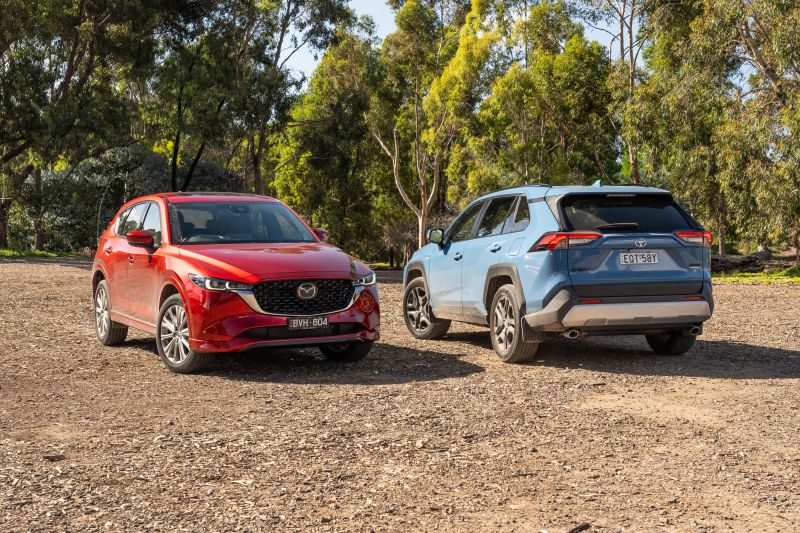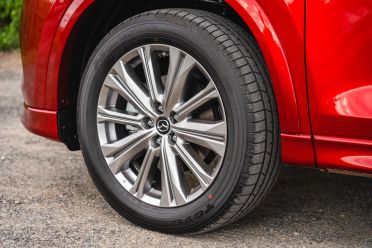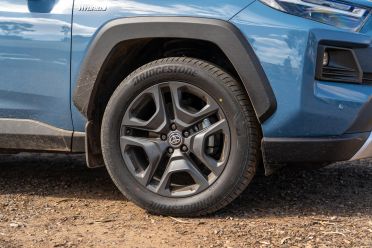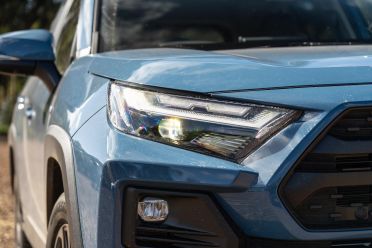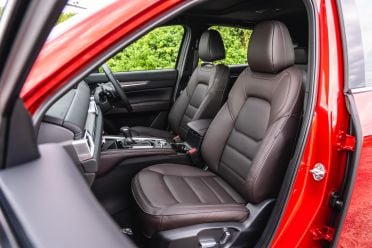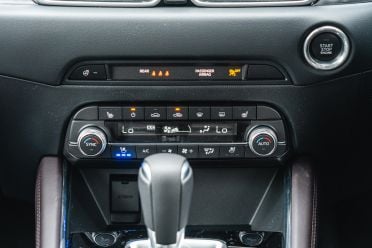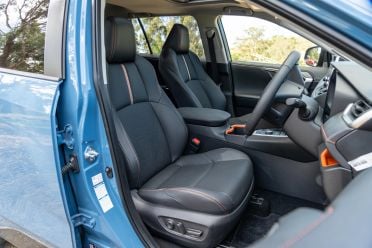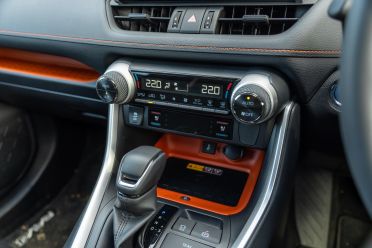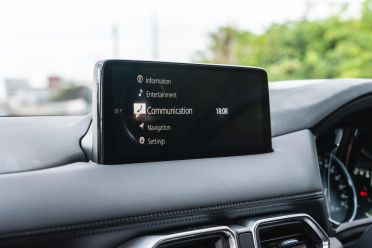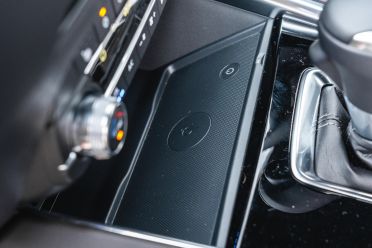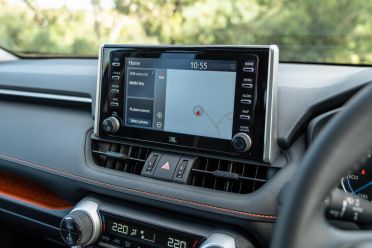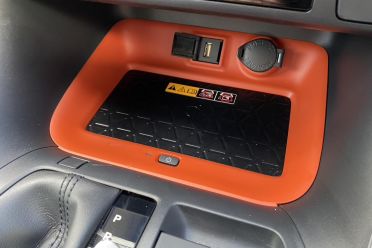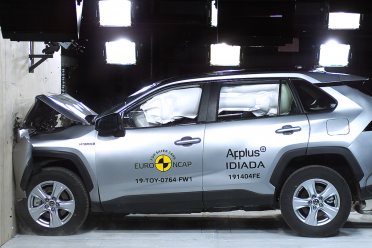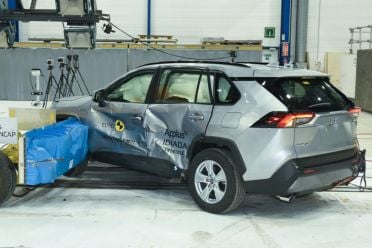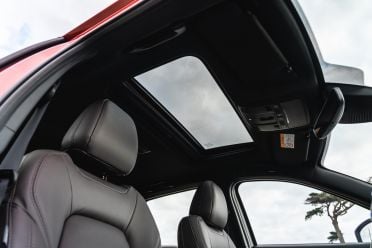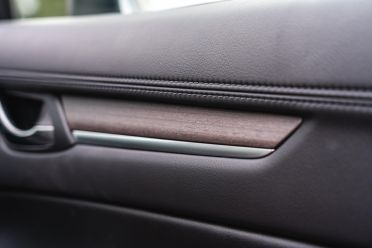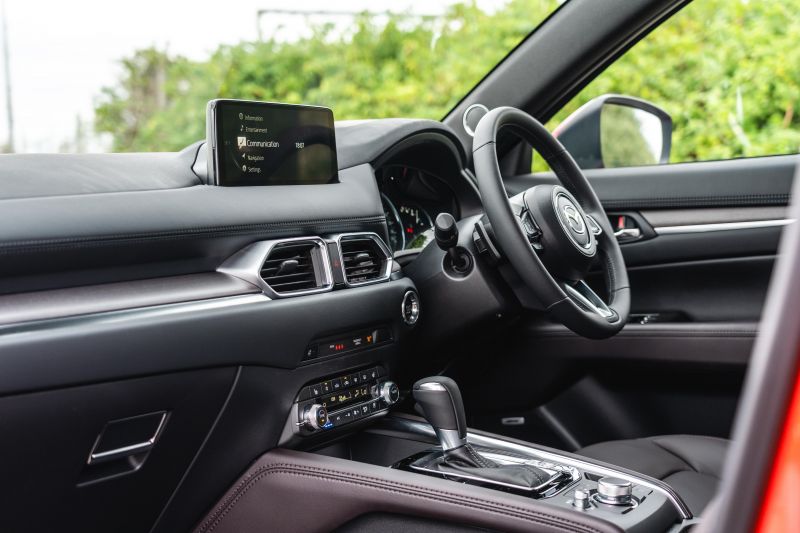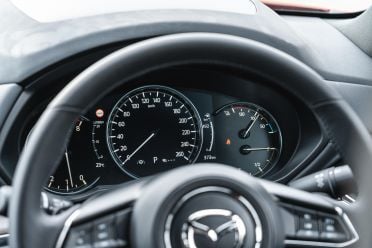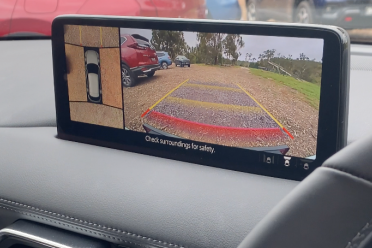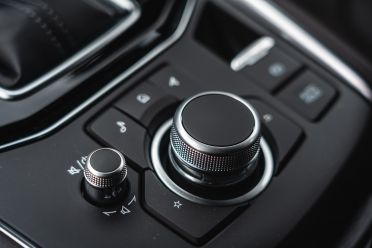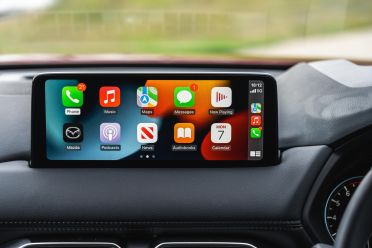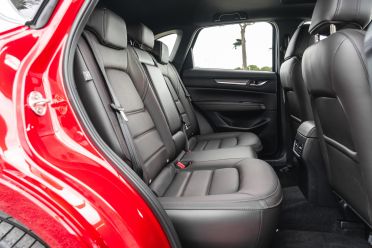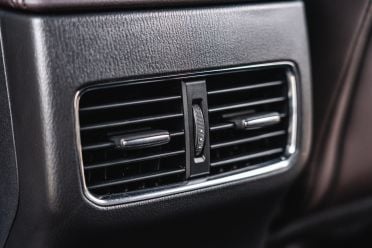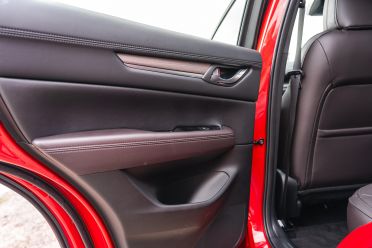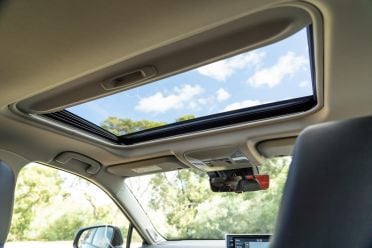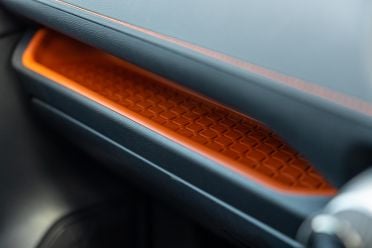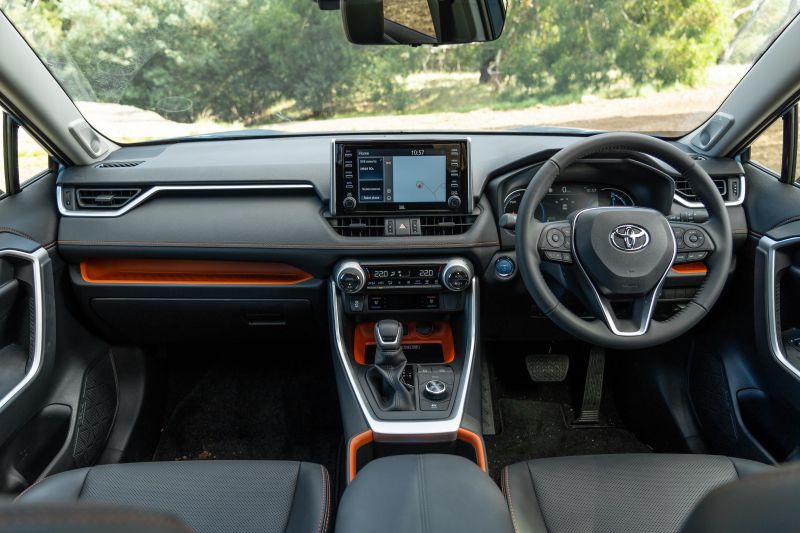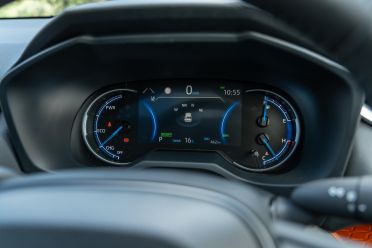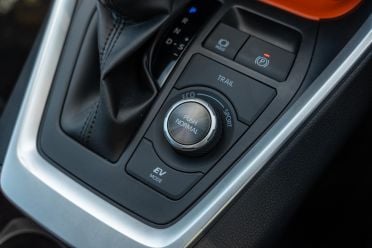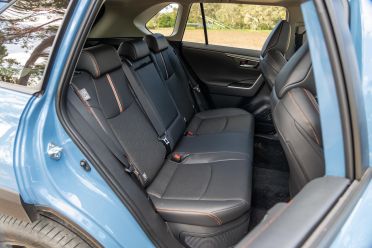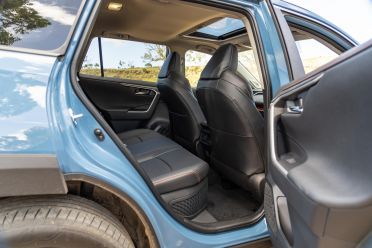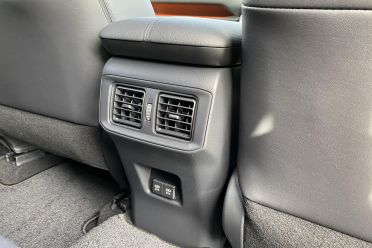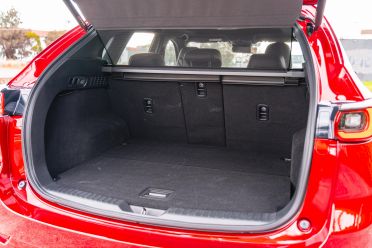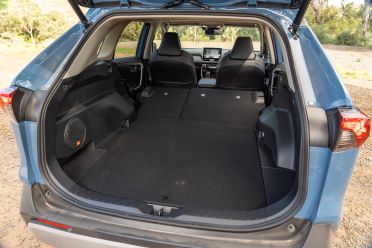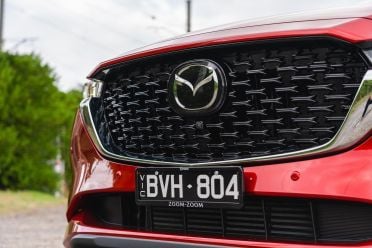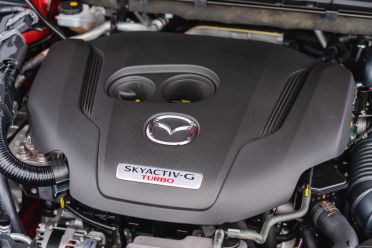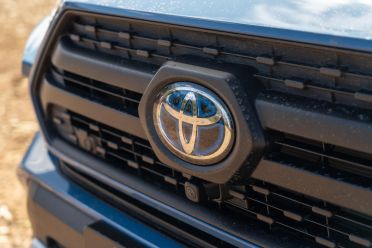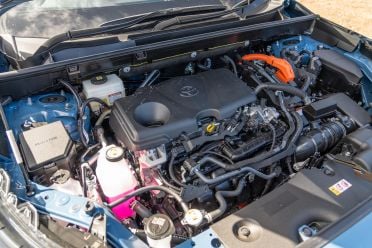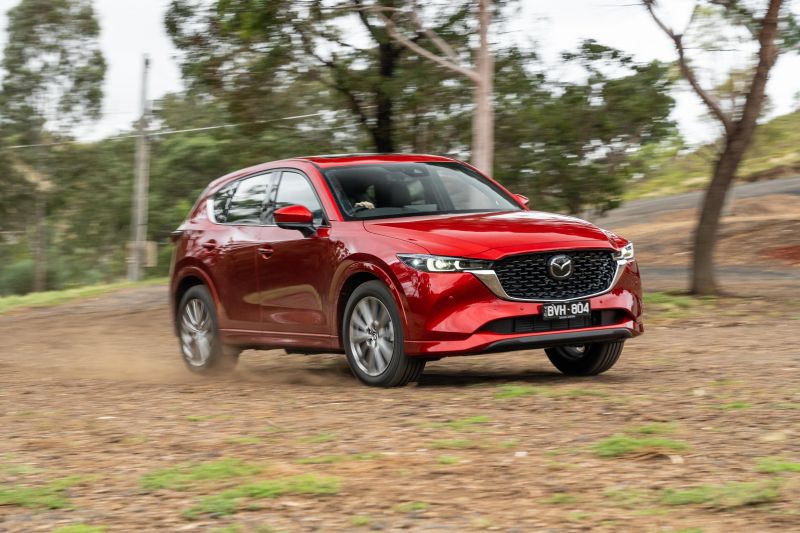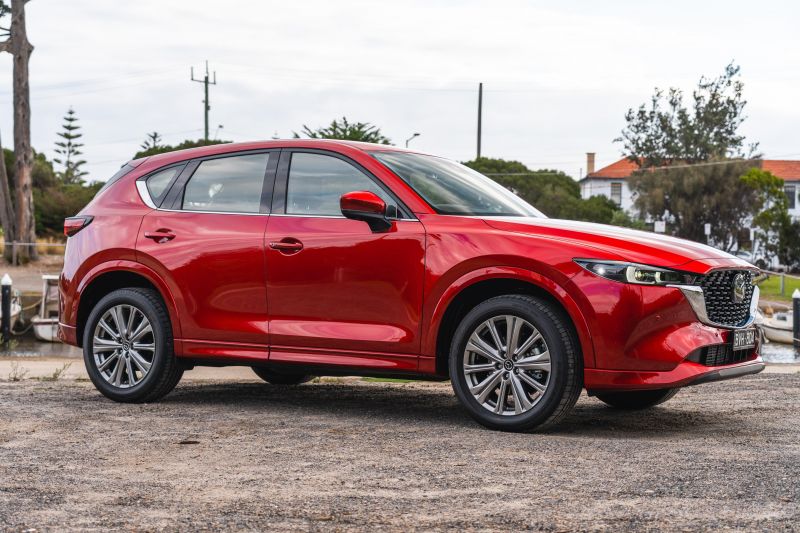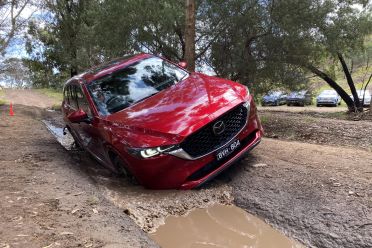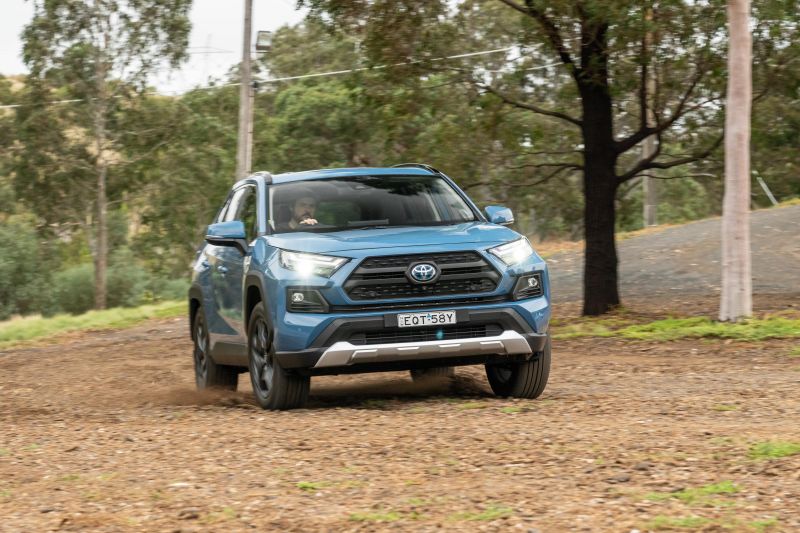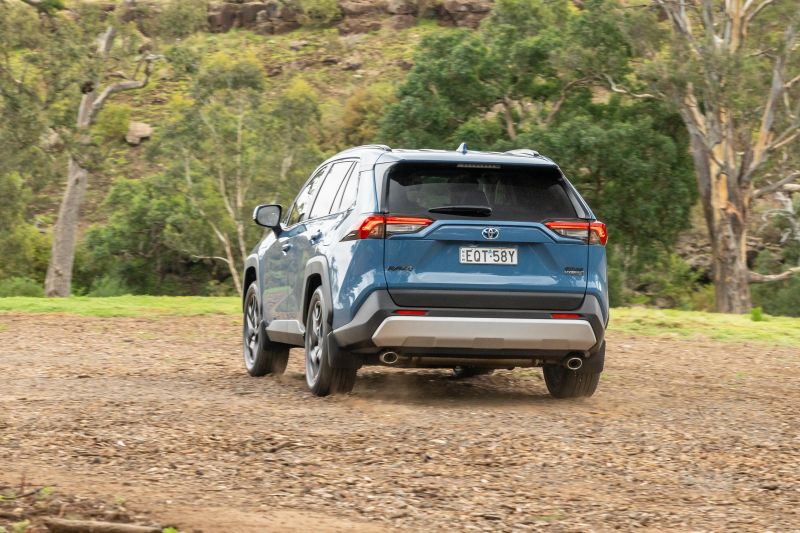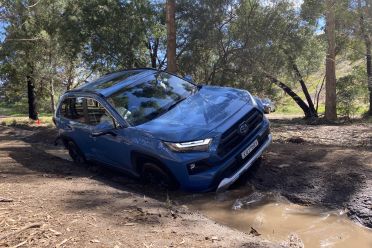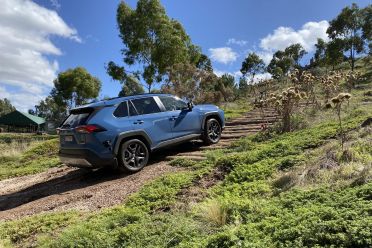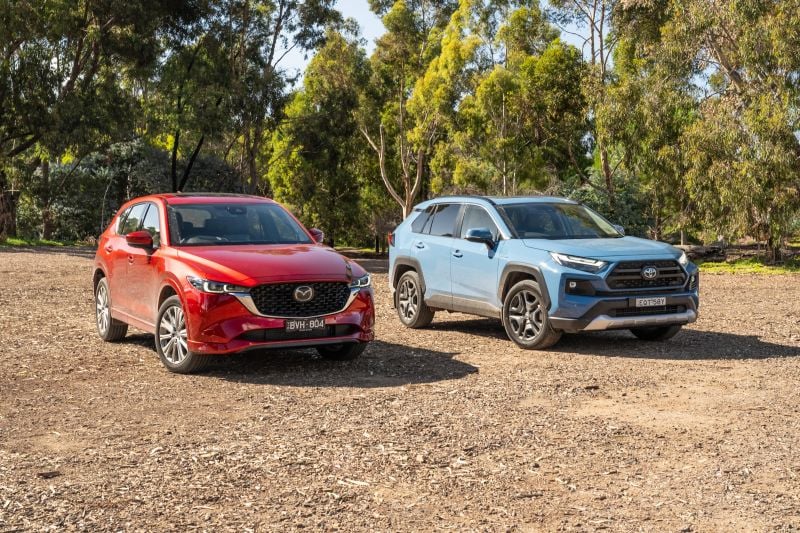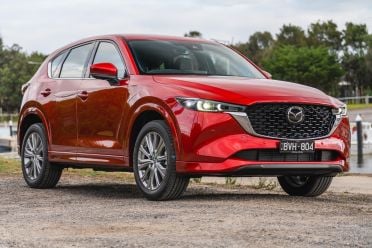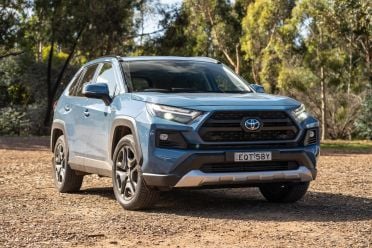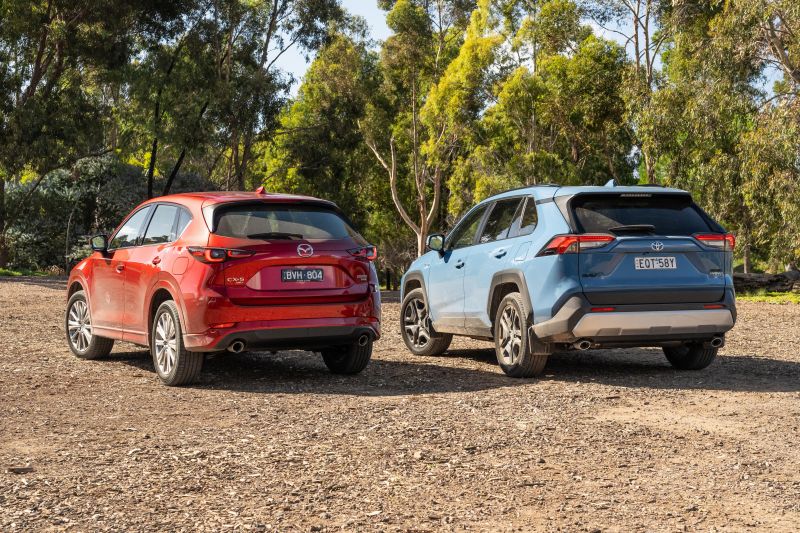You’re looking at Australia’s two biggest-selling SUVs, the Toyota RAV4 and Mazda CX-5, both of which recently received some updates for the current model year.
For those after a medium SUV with some rugged design cues and class-leading fuel economy, there’s the newly launched RAV4 Edge spec level with variant-first two-motor hybrid drivetrain.
And for those who want something with some ‘premium’ design cues and turbocharged performance, there’s the upgraded CX-5 Akera 2.5T.
Hopefully after reading this and watching the dedicated comparison video, you’ll have a better idea of which one is better suited to you.
How much?
This pair line up very closely on price, though not in terms of estimated delivery times.
Mazda Australia is reporting comparatively brief wait times compared to the more supply constrained RAV4, buyers of which have been waiting up to a year.
Mazda CX-5 Akera 2.5T
- List price: $53,380
- Drive-away*: $58,481
Toyota RAV4 Edge Hybrid
- List price: $52,700
- Drive-away*: $57,773
* Price based on a Melbourne postcode
What do you get?
Common features on the outside include 19-inch wheels with space-saver spares; LED headlights, tail lights and DRLs; auto-folding mirrors, a front-row sunroof, powered tailgates, and rain-sensing wipers. The Toyota adds roof rails.
| Mazda CX-5 Akera | Toyota RAV4 Edge | |
|---|---|---|
| Wheels | 19-inch | 19-inch |
| Spare tyre | Temporary | Temporary |
| Headlights | LED | LED |
| Tail lights | LED | Partial LED |
| Daytime lights | LED | LED |
| Mirrors | Auto-folding | Auto-folding |
| Sunroof | Standard | Standard |
| Tailgate | Powered | Powered |
| Wipers | Rain-sensing | Rain-sensing |
| Roof rails | No | Standard |
Inside there are common features such as heated and ventilated front seats, a powered driver’s seat, dual-zone climate control, proximity key (hands-free) access, and parking sensors front and rear.
The Mazda has Nappa leather seats compared to the Toyota’s ‘Softex’ synthetic leather designed to be harder-wearing, a powered front-passenger seat, heated back seats, a frameless electro-chromatic rear-view mirror, and a heated steering wheel.
The Toyota counters with a nifty digital rear-view mirror that uses a rear camera display.
| Mazda CX-5 Akera | Toyota RAV4 Edge | |
|---|---|---|
| Seat trim | Nappa leather | Softex synthetic leather |
| Driver’s seat functions | Heated, ventilated, powered | Heated, ventilated, powered |
| Passenger seat functions | Heated, ventilated, powered | Heated, ventilated |
| Heated back seats | Standard | No |
| Air-con type | Dual-zone climate control | Dual-zone climate control |
| Rear-view mirror | Frameless, auto-dimming | Digital via camera |
| Heated steering wheel | Standard | No |
| Proximity key | Standard | Standard |
| Parking sensors | Front and rear | Front and rear |
In terms of tech, both share satellite-navigation, wired Apple CarPlay and Android Auto, Bluetooth and USBs, digital radio, a wireless phone chargers, and a 360-degree camera view.
The Mazda’s upgraded 10.25-inch screen controlled by a rotary dial atop the transmission tunnel is larger than the Toyota’s 8.0-inch touchscreen, while the CX-5 also has a head-up display and its branded audio system has one extra speaker.
| Mazda CX-5 Akera | Toyota RAV4 Edge | |
|---|---|---|
| Head-up display | Standard | No |
| Infotainment screen | 10.25-inch | 8.0-inch |
| Sat-nav | Standard | Standard |
| Apple CarPlay | Standard | Standard |
| Android Auto | Standard | Standard |
| Audio system | Bose, 10 speakers | JBL, 9 speakers |
| Bluetooth/USB | Standard | Standard |
| Digital radio | Standard | Standard |
| Wireless charger | Standard | Standard |
| Camera view | 360-degree | 360-degree |
Are they safe?
Both the Mazda and Toyota have five-star crash ratings from independent tester ANCAP, with the following results:
Mazda CX-5
- Date stamp: 2017
- Adult occupant protection: 95%
- Child occupant protection: 80%
- Pedestrian/cyclist protection: 78%
- Safety assist features: 59%
- Crash report: Here
Toyota RAV4
- Date stamp: 2019
- Adult occupant protection: 93%
- Child occupant protection: 89%
- Pedestrian/cyclist protection: 85%
- Safety assist features: 83%
- Crash report: Here
| Mazda CX-5 Akera | Toyota RAV4 Edge | |
|---|---|---|
| Airbags | Front, front-side, curtain | Front, front-side, curtain, driver’s knee |
| Child seats | 2 x ISOFIX, 3 x top tether | 2 x ISOFIX, 3 x top tether |
| Autonomous emergency braking | Car and vulnerable road user | Car and vulnerable road user |
| Lane-keeping aid | Corrective steering, alerts | Corrective steering, alerts |
| Blind-spot monitoring | Standard | Standard |
| Rear cross-traffic alert | Standard | Standard |
| Cruise control type | Adaptive | Adaptive |
| Traffic sign readout | Standard | Standard |
What are they like inside?
Mazda
The Mazda gives a more convincing impression of luxury, with its soft Nappa leather seats, tasteful wood inserts, matching brown leather armrest and centre tunnel padding, knurled dials, and flat silver trim inserts. The padded dash also feels very ‘Lexus’.
Settle into the (heated, ventilated and powered) driver’s seat and you’re presented with a leather-wrapped and tastefully stitched steering wheel with clean and simple buttons, ahead of a cluster with centre speedo TFT that changes colours, and a head-up display on the windscreen showing speed digitally and the current limit.
The big change is the new, larger centre display running Mazda’s latest operating system from the Mazda 3, CX-30 and other new-gen products. It’s a much cleaner, quicker and more attractive setup than the old CX-5’s dated system with its full-width maps, and is paired to a cracking-good stereo.
The main user-interface issue is the fact the rather distant centre display doesn’t have touch functionality, meaning you rely on the (unchanged) centre-tunnel rotary dial with shortcut buttons, which doesn’t work well with Android Auto or Apple CarPlay mirroring.
Storage options comprise a mid-size centre console with two USBs, bottle holders in the door, a felt-lined glovebox, and cupholders with teeth just behind the infotainment controller.
In terms of cabin space, the CX-5 has never been the roomiest in its class. Open the back doors and you’re presented with a bench comprising two longer-base outboard (heated) seats and a more meagre centre spot impeded by the centre tunnel.
There’s room for two adults behind two others nevertheless – I’m 194cm and was in work boots, and my knees just touched the seats ahead – and the head space is retained because unlike some other rivals it lacks a panoramic glass roof. But there are similarly sized SUVs out there with more spacious, airy setups.
There are plenty of back-seat amenities too, beyond the expected rear vents, including a flip-down centre armrest incorporating cupholders, USBs and seat heater buttons. And Mazda doesn’t cut costs by downgrading rear trims, because it all feels about as premium in the back as it does up front.
The boot is a smaller-than-average 438 litres and is accessed by a powered tailgate. Its flexibility bonafides are enhanced by the clever soft bag cover that moves with the tailgate, and levers in the rear to shortcut-fold the 40:20:40 rear bench seat for longer items.
Toyota
The RAV4 imparts a chunkier, bolder, and brighter look, and trades the premium-looking materials for lower-maintenance stuff, exemplified by the synthetic leather seats with orange piping and good bolstering.
The bright orange theme continues throughout, incorporating the stitch-work, and various plastic inlays in and around storage areas. I like the chunky rubberised ventilation controls, knurled and illuminated drive mode selector, and relative lack of glossy black trim. Rare…
Behind the leather-wrapped wheel with its (again) nicely damped buttons is a medley digital and analogue cluster with a few extra menus and animations, but no HUD like the Mazda.
The touchscreen is more CarPlay/Android-friendly, but it’s otherwise an inferior system to the Mazda’s – in terms of size, resolution, input processing and usability. Fine for a Corolla, but it feels like a $50,000-plus SUV should offer something a little swisher.
Extra storage includes a signature open section ahead of the front passenger, and a slightly more capacious console. It also has a bonus digital rear-view mirror which is handy if you have a full boot or three rear passengers.
The back seats offer vents, USBs and cupholders, and the floor is mostly flat meaning better foot placement for rear-centre occupants thanks to the use of two-motor AWD. Legroom, foot-room and headroom is superior for taller occupants, and it feels airier.
Boot capacity measures a more substantive 580L litres with five seats in use and the two-height floor at its lower setting. The tailgate is powered, but there are no levers in the boot to swiftly fold the middle seats.
In essence, the Toyota’s is brighter, brasher and roomier, whereas the Mazda’s is a more premium experience with superior tech. if you have destructive kids, then just quietly I’d be worried about them scuffing up that lovely CX-5…
Just a reminder to be sure to watch the video embedded higher up the story, in which Paul gives a visual breakdown of the respective interiors.
| Mazda CX-5 Akera | Toyota RAV4 Edge | |
|---|---|---|
| Length | 4575mm | 4615mm |
| Width | 1845mm | 1865mm |
| Height | 1680mm | 1690mm |
| Wheelbase | 2700mm | 2690mm |
| Clearance | 200mm | 195mm |
| Boot | 438L | 580L |
What’s under the bonnet?
Mazda
The CX-5 can be had with a cheaper naturally aspirated 2.5-litre petrol and a more efficient 2.2-litre twin-turbo diesel, but the engine option Mazda loaned us was the 2.5-litre turbo-petrol.
It pushes out a potent (for the segment) 170kW of power and a diesel-like 420Nm of torque through an on-demand all-wheel drive (AWD) system and six-speed automatic transmission.
It can tow 2000kg and uses a claimed 8.2 litres of fuel per 100km.
Toyota
The RAV4 Edge comes with a 2.5-litre naturally aspirated engine option but the vast majority of buyers go for the hybrid, which is a real unique selling point in these times of mega fuel prices.
The Toyota’s drivetrain pairs a 2.5-litre petrol running the leaner Atkinson cycle, paired with a 88kW and 202Nm front motor-generator and 40kW and 121Nm rear motor-generator, plus a small battery charged by the engine and brake-energy recuperation.
It uses an e-CVT transmission and the AWD system uses the rear axle motor. Nifty. It can tow 1500kg and uses a crazy-good 4.8L/100km using 91 RON on the ADR combined cycle.
| Mazda CX-5 Akera | Toyota RAV4 Edge | |
|---|---|---|
| Engine | 2.5-litre, 4-cyl, turbo | 2.5-litre, 4-cyl |
| Electric motor/s | NA | Front and rear |
| Power | 170kW @ 5000rpm | 163kW |
| Torque | 420Nm @ 2000rpm | No total listed |
| CE’s 0-100km/h | 7.52sec | 8.32sec |
| Fuel economy | 8.2L/100km | 4.8L/100km |
| Fuel required | 91 RON petrol | 91 RON petrol |
| Transmission | 6-speed automatic | e-CVT |
| Driven wheels | Driveline AWD | Two-motor AWD |
| Towing capacity | 2000kg | 1500kg |
| Kerb weight | 1730kg | 1760kg |
How do they drive?
Mazda
Mazda does a better job putting the ‘S’ into Sport Utility Vehicle, with the 2.5-litre turbo putting out hot hatch levels of power and torque, complete with a raspy note.
With plenty of torque available low in the rev band, it always feels like it has muscle in hand for rolling acceleration, and was eight-tenths of a second quicker to 100km/h than the electrified Toyota.
The transmission only has the six speeds, but it’s nicely calibrated and spaced, and in the sports mode (accessed by a rocker switch, which also changes the instrument display colour) offers more aggressive downshifts and hangs onto lower gears a bit longer.
It’s not the most frugal medium SUV contender though: the claim is 8.2L/100km but I averaged a less impressive 9.4L/100km on a typical loop, whereas Paul in his video (with more city driving) averaged 11.3L/100km, as to be expected.
The AWD system favours the front wheels but uses slip sensors to shuffle torque to the back wheels when needed, although it doesn’t entirely mitigate torque steer on hard acceleration. At times, it just has a bit too much punch for the front tyres.
That engine is matched by generally sharp handling, with quite good body control and nicely weighted and direct steering. And while the ride isn’t too soft, the suspension is also quite good at ironing out road imperfections like potholes, gravel, or cattle grates.
One area where Mazda has made leaps and bounds is in terms of noise, vibration and harshness (NVH) suppression, which is first-rate, filtering out tyre and wind noise like a wannabe luxury car should.
While it’s no proper 4×4, it proved quite capable during light duty soft-roading, eventually shuffling torque to the tyre with the most surface contact. It has a decent 200mm clearance, and an off-road mode that tweaks the traction control to suit soft surfaces.
Toyota
The hybrid engine is a real no-brainer over the petrol-only Edge if you can brave the waiting list, with the $2500 premium well worth paying – especially with current pump prices.
It relies on the silent e-motors on startup and when reversing, and more importantly generally rolls off the mark without using petrol too. When the engine does fire up, it does so with less noise and fewer vibrations because of this, and torque holes are filled in.
If you need to overtake or just want to get somewhere faster, the e-CVT in this hybrid is far better at reducing rev flare than previous generations, and the overall 163kW system power output is substantial, as the still-brisk 0-100km/h time showed. It’s not slow in the least.
It’s also just brilliant at saving petrol. Toyota claims outstanding fuel economy of 4.8L/100km, giving it a theoretical range north of 1100km. My overall average doing a combined-cycle loop designed to reflect an array of users, was a still-great 5.7L/100km.
If you drive 300km per week, you’d expect to use around 10L less in the RAV4, meaning close to $20 per week saved. This, of course, is an example that won’t be relevant to all drivers.
It has good road manners, particularly when it comes to smoothing out big impacts (like settling after speed bumps) and when negating pocked, pothole-laden tarmac. All the vehicles on Toyota’s new TNGA platform feel stiff, quite agile, and generally comfortable.
The RAV4 doesn’t feel quite as punchy as the CX-5, its steering isn’t as resistant, and it offers a more relaxed road feel overall, with greater outward visibility as well.
The praise isn’t universal. This model uses a rear axle e-motor to run the AWD system instead of the petrol’s mechanical system, which in theory sounds great.
An integrated management system controls engine, transmission, steering, torque distribution and brakes, and in Edge form the usual Sport/Eco/EV modes are joined by a Trail mode that applies braking force to a slipping or freely rotating wheel, when cocked.
It didn’t seem to work all that effectively in our testing however, taking a few seconds to re-distribute drive torque over offset moguls, and battling when restarting halfway up a logged surface.
| Mazda CX-5 Akera | Toyota RAV4 Edge | |
|---|---|---|
| Front suspension | MacPherson strut | MacPherson strut |
| Rear suspension | Trailing wishbone | Multi-link |
| Steering type | Electric assisted | Electric assisted |
| Turning circle | 11m | 11m |
Cost of ownership
Both manufacturers offer five-year warranties without distance caps. Each brand also offers capped-price servicing, though the Mazda has shorter intervals.
The below costs are a guide as per each company’s transparent service calculators, and may change. We’ll just list five years of cover for brevity.
Mazda CX-5
- One year or 10,000km: $363
- Two years or 20,000km: $393 + $72 for brake fluid
- Three years or 30,000km: $363 +$99 for engine air filter
- Four years or 40,000km: $393 + $72 for brake fluid, $83 for cabin air filter
- Five years or 50,000km: $363
Toyota RAV4
- One year or 15,000km: $230
- Two years or 30,000km: $230
- Three years or 45,000km: $230
- Four years or 60,000km: $230
- Five years or 75,000km: $230
The Toyota is both cheaper to refuel, and cheaper to maintain.
CarExpert’s Pick
As always, your ideal choice depends on your preferences.
The Mazda CX-5 Akera feels like a more premium vehicle in terms of interior materials and sound-deadening, has a more characterful and punchy drivetrain, and better infotainment.
By contrast the Toyota RAV4 Edge has a more spacious and airy interior, substantially better fuel economy with lower emissions, and promises lower overall maintenance costs. Yet it’s also good to drive and quick off the mark, so you aren’t sacrificing much.
To my sensibilities, the RAV4 earns its top-seller status because it’s better at fulfilling what I consider the ideal mid-sized SUV brief. But it’s a narrow-run thing, and the Mazda remains a premium-feeling alternative to some more expensive competitors.
Remember to watch the comparison video embedded above, and for more detail watch the respective single-car review videos below. And as always, tell us your thoughts in the comments!

